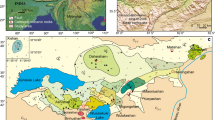Abstract.
Chausudake Volcano is representative of the active volcanoes in northeastern Japan, and has a record of many historical eruptions. Because its 16-ky eruptive history is well documented, Chausudake is well-suited for examining the temporal change of magma chamber processes and for assessing potential hazards. The activity of the Chausudake Volcano can be divided into six magmatic units (CH1–CH6). Most of its products have similar characteristics, but those from unit CH1 show wider variation. Most rocks are andesite and have plagioclase, clinopyroxene, orthopyroxene, and Fe–Ti oxides as phenocrysts, with or without olivine or quartz. Mafic inclusions, which are observed in most products, are basaltic andesites that have various combinations of the same phenocryst species. Petrographic features observed in host rocks and mafic inclusions, such as disequilibrium phenocrysts and resorbed textures, suggest magma mixing/co-mingling. Whole rock compositions of both host rocks and mafic inclusions show linear trends in variation diagrams, which suggest that the rocks are derived from the mixing/co-mingling between mafic and felsic end members. Bulk silica content of the mafic end-member magma is estimated to be ca. 52%, and contains Mg-rich olivine and An-rich plagioclase. The temperature of this end member is estimated to have been higher than 1,100 °C. Bulk silica content of the felsic end-member magma is estimated to be ~66%, and contains Mg-poor pyroxenes, An-poor plagioclase, and quartz phenocrysts, with a temperature of between 800 and 900 °C. Trace element compositions show that the end members have different origins, but have changed little over the entire 16-ky of activity. The mafic end-member magmas might come from a lower-crustal homogeneous, large magma chamber, whereas the felsic end-member magmas may be partial melts of crustal materials produced by the heat of the mafic end member. Felsic end-member magma may have accumulated in the middle crust before CH1 activity. The mixing ratio of the felsic to mafic end members was 0.5:0.5 to 0.4:0.6 for the CH1 unit, and ca. 0.4:0.6 for the other units. Considering that ca. 75% of the total volume of the eruptive products form the first unit, its wider compositional variation is attributed to more heterogeneous mixing ratios.
Similar content being viewed by others
Author information
Authors and Affiliations
Additional information
Electronic Publication
Rights and permissions
About this article
Cite this article
Ban, M., Yamamoto, T. Petrological study of Nasu-Chausudake Volcano (ca. 16 ka to Present), northeastern Japan. Bull Volcanol 64, 100–116 (2002). https://doi.org/10.1007/s00445-001-0187-9
Received:
Accepted:
Issue Date:
DOI: https://doi.org/10.1007/s00445-001-0187-9




